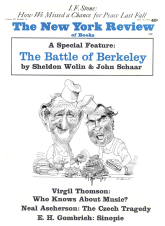To the Editors:
…It is never clear what, if anything, Miss Arendt is for or against. At one point, she seems merely to be championing the cause of intellectual clarity: “It is, I think, a rather sad reflection on the present state of political science that our language does not distinguish between such key terms as power, strength, force, might, authority, and, finally, violence.” Just what the difference is between power, strength, force and might, she never bothers to explain. Nor has she anything further to say about authority. As for power and violence, her efforts at clarifying the difference are so wide of the mark as to justify the suspicion that she identifies power with authority, thus blessing the establishment, and violence with resistance to authority, thus condemning efforts at radical change. For the simple, common sense difference between power and violence is that the word, “power,” is morally neutral, it can be applied equally to what is legitimate or illegitimate, while “violence” connotes illegitimate or excessive use of force. “Power,” like “strength,” is a dispositional term, signifying the ability to exert force or to get things done, while “violence” is an activity term, signifying the actual exertion (unjustifiably) of force. The important difference is the difference in moral implication between the use of legitimate power and resort to illegitimate power, i.e., violence. This simple linguistic fact seems to have escaped Miss Arendt’s attention, apparently because she believes that her task is too loftily metaphysical to involve her in partisan judgments about who is right and who is wrong. But if one is too far above the political battle to make judgments of right and wrong, then one simply cannot employ the term “violence,” whose function is to label actions as wrong, except in the most conventional way, namely, on the assumption that whatever the mass media call “violence” is properly so-called, whether one approves of it or not.
This is the point I wish to make: to apply the term “violence” to some actions and not to others is to condemn the first group and to excuse the second. The fact that, throughout her essay, after the first few perfunctory paragraphs, Miss Arendt concerns herself exclusively with the “violence” of the Left (she criticizes the Left at length for failing to appreciate Marx’s rejection of violence, but she conveniently overlooks Marx’s prediction that violence would be initiated by the ruling class) and has nothing further to say about the ruthless bombings of civilian populations, the mass arrests and deportations, the suspension of civil liberties, the constant threats of “massive retaliation,” and “we will bury you,” the nuclear missiles pointed at other nations, the infiltration of neighboring countries by spies, and all the other abominations being perpetrated by respectable governments. This, one would think, is the serious problem of violence, not the bricks thrown at cops by a few students.
To be obsessed with the relatively trivial and defensive violence of left-wing students and black militants, while ignoring’ the monumental violence of governments, betrays a moral insensitivity characteristic of all those devotées of “law and order” who see the starvation, oppression, and extermination of millions as the exercise of authority, and the anguished resistance of a handful of teen-agers as violence. The issue is not, what is violence—that is child’s play disguised as metaphysics—the issue is: who is committing violence upon whom? On this burning political question, Miss Arendt has nothing to say.
Raziel Abelson
Department of Philosophy
New York University
This Issue
June 19, 1969



